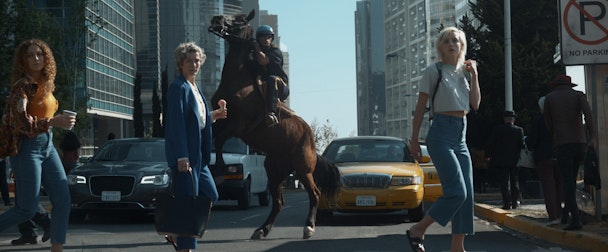
Advertisement

FE 2
As Formula E embarks on its seventh season, the new sport is gearing itself as the future of motorsport. The Drum talks to Formula E and its ad agency Uncommon, who explain how ‘Change Accelerated’ will help the sport reach its full potential.
“The world didn’t need another motorsport,” chief branding officer Henry Chilcott remarks on the advent of Formula E. “The reason Formula E came into existence was through its capacity to make a positive impact to the world.” The first sport to have a net zero carbon footprint, Formula E positions itself as the clean, future-facing alternative to Formula 1 (F1).
Now in its seventh season, while it is relatively new to the circuit, Formula E already boasts some of the greatest manufacturers in motorsport history, with Jaguar, BMW, Nissan, Audi and, most recently, Porsche and Mercedes battling it out for the title this season. However, it is still at the teething stage of its existence. At the end of 2020, BMW and Audi made the shock announcement that they would be leaving at the end of the 2020/21 season, citing difficulties developing the right technologies, which came as a blow to the new sport.
Despite this, Formula E’s audience is growing. Last year, the cumulative broadcast audience for season 6 was 273 million, while its global brand awareness sits at 460 million.
Chilcott explains that Formula E exists for three core audiences – the fans, the teams and the manufacturers, and its sponsors. “The fans ultimately need to believe in the sport – that it can be just as exciting as F1,” he says. “The partners need to believe this is a powerful platform, against which they can tell stories that classically sit at the intersection of technology, performance and sustainability.
“And manufacturers need to believe that the way we’re positioning the brand is going to help them attract a new generation of electric vehicle purchases,” Chilcott explains. While sport is Formula E’s raison d'être, it also plays a valuable role in driving the electric vehicle revolution.
“Some guy in a Prius is not going to convert somebody,” argues Nils Leonard, founder of Uncommon. “Whereas Formula E is that badass brand that actually has a hope of doing that.”
Last year Uncommon was delivered a brief to help Formula E reach its full potential. “It can be cool, it can be dangerous, it can be ethical, and it can be luxurious,” Leonard says of the unusual but opportunistic space that Formula E occupies. “I was really keen that Formula E wasn’t just seen as the ‘right’ choice, rather than the fucking exciting one. Because that’s what racing is all about. It’s about risk and death.”
And so they began figuring out what strategic message the brand should send out. “If you look at the world today, there are many brands and organizations that talk about change,” says Chilcott. “Because the world’s crying out for it at the moment. There are some brands out there that actually demonstrate the drive to make change happen. And then there’s some brands that make change happen faster.”
“Formula E’s very existence drives forward with greater pace,” says Chilcott on the new positioning – ‘Change Accelerated’ – which he says encapsulates Formula E’s vision to accelerate sustainable human progress through the power of electric racing.
To bring ‘Change Accelerated’ to life, Uncommon has created a film that would situate electric racing as the future of the sport, hinging on the notion that Formula E has the capacity to excite the next generation of sports fans.
Leonard shares that they actually found the track before they began work on the film. “Singularity sounds like one of the cars – badass and cool. We were listening and listening to the track, thinking it's expansive, it’s epic, it’s dangerous, a little bit dark. What experience could match that?” he says.
Beyond its sustainability credentials, one major difference between F1 and Formula E is the latter’s races take place in temporary city center street circuits and not at the race track. “We loved the idea of the cars going past on the street,” he recalls. “We wanted people to be as shocked at the idea of cars going past as they might be at the change it was creating.”

The film visits the seven destinations that Formula E will take place this season – London, New York, Berlin, Diriyah, Valencia, Puebla and Monaco – although instead of depicting big, distinctive landmarks, the approach was more subtle, yet still identifiable.
As the film zooms through the streets, where the viewer sits from the perspective of the race car, everything is slowed down. “The technique of going past things slowly is not new,” Leonard admits. “But the way that the director Marcus Söderlund and our exec creative director Sam Walker filmed it was really special. I remember conversations between them too, where there was a point at which Marcus was arguing, ‘it’s going too fast!’ when we were shooting at a bajillion frames per second. We were addicted to slowness, to this stillness.”
The last piece of the puzzle is the transfixing voice of Arthur C Clarke. “Arthur is a reference point. He’s almost fictional when you watch this clip of him predicting what the future will look like,” Leonard muses.
“It’s insane how right he is about what the future holds. There’s a cunning trick with an old voice, it really works. There’s a truth in it. We’re all used to hearing voice-overs of people, but when you hear that voice and it has that crackle and his beautiful British politeness, there’s this ferocious hope.”
You can watch the ad in full below.